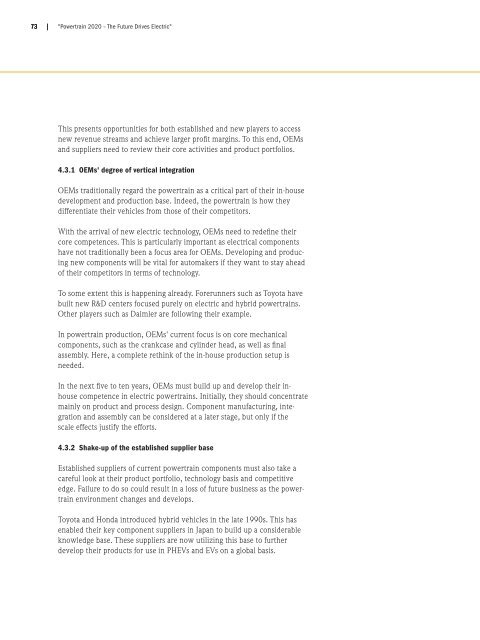Powertrain 2020 - The Future Drives Electric (PDF ... - Roland Berger
Powertrain 2020 - The Future Drives Electric (PDF ... - Roland Berger
Powertrain 2020 - The Future Drives Electric (PDF ... - Roland Berger
Create successful ePaper yourself
Turn your PDF publications into a flip-book with our unique Google optimized e-Paper software.
73 |<br />
"<strong>Powertrain</strong> <strong>2020</strong> – <strong>The</strong> <strong>Future</strong> <strong>Drives</strong> <strong>Electric</strong>"<br />
This presents opportunities for both established and new players to access<br />
new revenue streams and achieve larger profit margins. To this end, OEMs<br />
and suppliers need to review their core activities and product portfolios.<br />
4.3.1 OEMs' degree of vertical integration<br />
OEMs traditionally regard the powertrain as a critical part of their in-house<br />
development and production base. Indeed, the powertrain is how they<br />
differentiate their vehicles from those of their competitors.<br />
With the arrival of new electric technology, OEMs need to redefine their<br />
core competences. This is particularly important as electrical components<br />
have not traditionally been a focus area for OEMs. Developing and producing<br />
new components will be vital for automakers if they want to stay ahead<br />
of their competitors in terms of technology.<br />
To some extent this is happening already. Forerunners such as Toyota have<br />
built new R&D centers focused purely on electric and hybrid powertrains.<br />
Other players such as Daimler are following their example.<br />
In powertrain production, OEMs' current focus is on core mechanical<br />
components, such as the crankcase and cylinder head, as well as final<br />
assembly. Here, a complete rethink of the in-house production setup is<br />
needed.<br />
In the next five to ten years, OEMs must build up and develop their inhouse<br />
competence in electric powertrains. Initially, they should concentrate<br />
mainly on product and process design. Component manufacturing, integration<br />
and assembly can be considered at a later stage, but only if the<br />
scale effects justify the efforts.<br />
4.3.2 Shake-up of the established supplier base<br />
Established suppliers of current powertrain components must also take a<br />
careful look at their product portfolio, technology basis and competitive<br />
edge. Failure to do so could result in a loss of future business as the powertrain<br />
environment changes and develops.<br />
Toyota and Honda introduced hybrid vehicles in the late 1990s. This has<br />
enabled their key component suppliers in Japan to build up a considerable<br />
knowledge base. <strong>The</strong>se suppliers are now utilizing this base to further<br />
develop their products for use in PHEVs and EVs on a global basis.

















